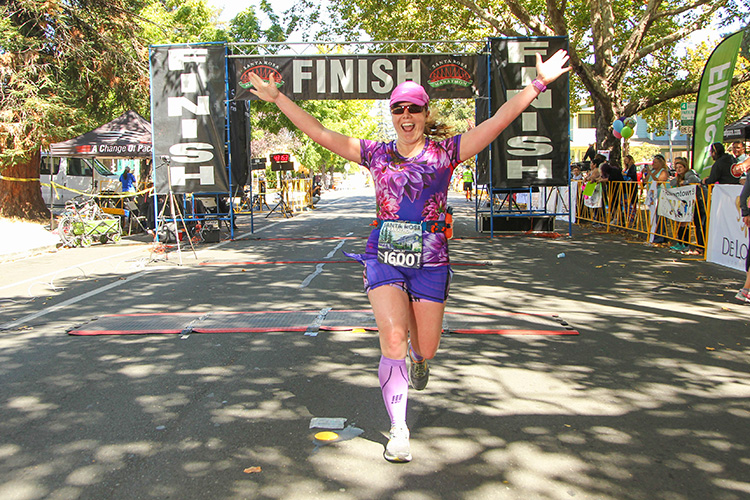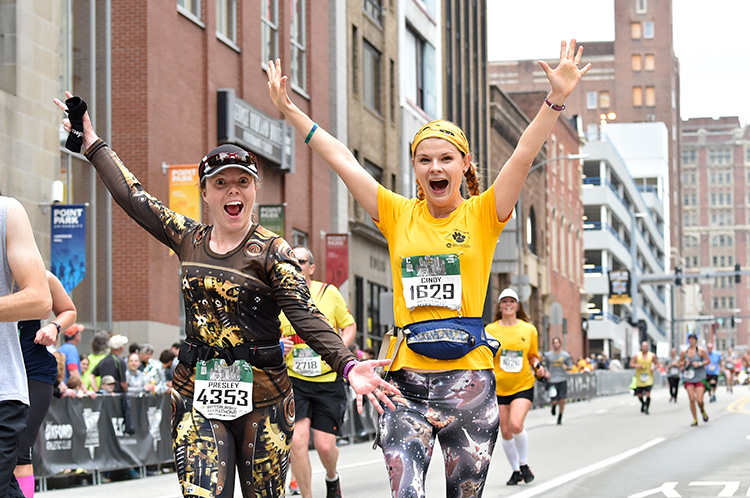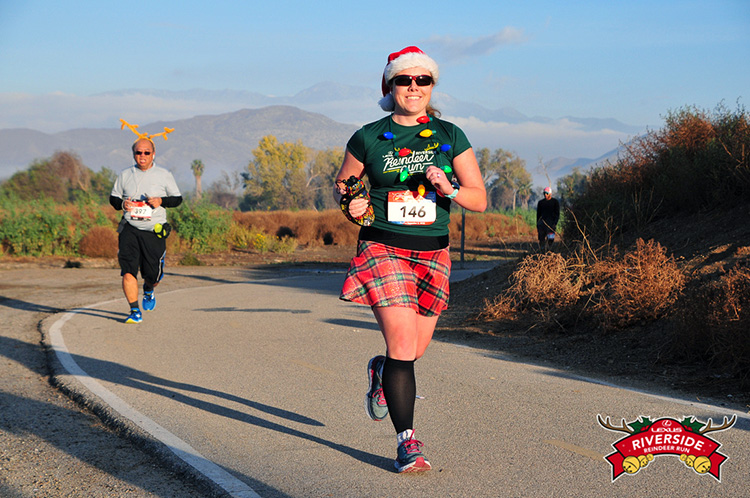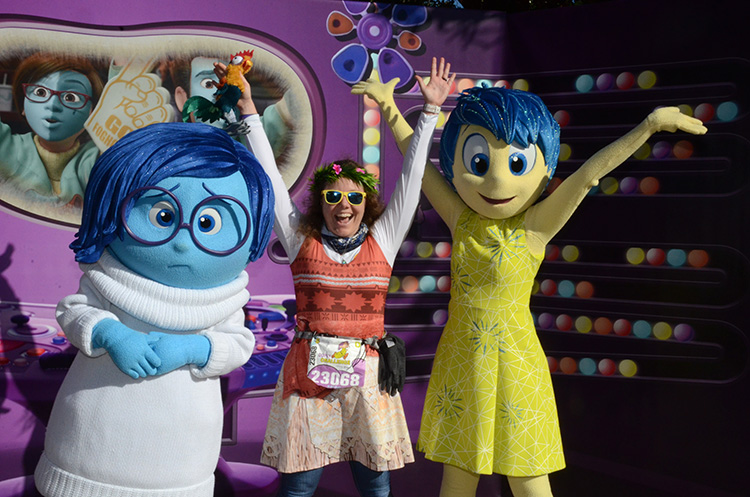
Life can change in a heartbeat — just ask Sarah Presley Dasaro. On the evening of September 6, 2012, the Pasadena Police Department Community Services Officer and avid runner was enjoying a relaxing evening with her boyfriend when an aneurysm — an abnormally dilated blood vessel — ruptured in her brain, causing internal bleeding that required emergency life-saving surgery. As if that weren’t enough, corrective heart surgery soon followed to repair a constricted aorta.
Whereas either of these setbacks alone would have derailed most running careers, Sarah didn’t just survive — thanks to a positive mindset and tireless work ethic, she thrived. Less than six months after having a platinum coil inserted in her brain and less than three months after having a corrective stent implanted in her aorta, Sarah completed the 2013 Pasadena Rock ‘n’ Roll Half Marathon. She has since completed 175+ races including more than 20 marathons, with plenty of finish lines still in sight.
With September being not only the 7th anniversary of her own near-death experience but Brain Aneurysm Awareness Month, we caught up with Sarah to talk about the day her world turned upside-down, running’s central role in her recovery, and how she turned one of life’s most sour lemons into her own bottomless glass of lemonade.
RR: There’s no better place to begin than the beginning, so tell us… how did you get started as a runner?
SPD: I was 21 years old in 2004 when a friend who wanted to get into better shape told me he was going to go run a mile at the Pasadena City College track. Back then I was not a runner and thought a mile was an incredibly far distance. I hated running, but apparently I’m a glutton for punishment because I told him I wanted to go with him. Slowly, we ran four laps around the track. I had never run a mile continuously in my life; it was awful, but I liked it. Shortly after finishing, the idea of running a marathon popped into my head, although I didn’t yet know how far a marathon actually was. Regardless, I started telling friends I was going to run a marathon.
RR: How did your early running goals evolve?
SPD: Upon deciding I wanted to run a marathon, I started hitting the treadmill at the gym. I would hammer out two to four miles at a time. Unfortunately, I was in pain after most runs. On a few occasions, I had difficulty walking back to my car. I didn’t know what the pain was at the time, but I now recognize I had plantar fasciitis in one foot and Iliotibial (IT) Band Syndrome in the opposite leg.
The problem? I was running in sneakers that weren’t intended as running shoes. Back then, I didn’t know there was a difference between the two. Someone suggested I go out and buy actual running shoes, so I did — I marched right on down to DSW and picked out a “nice” pair of shoes from the “running” section. I then had an easier time running, but I was still hurting.
Around this time, I got a flyer in the mail for Team In Training. I saw they were about to start training for the 2005 San Diego Rock ‘n’ Roll Marathon. Perfect! I would raise money for the Leukemia & Lymphoma Society, and in return they would teach me to run a marathon!
I managed to drag two friends to the Team In Training informational meeting to sign up. It was there that I found out a marathon was… 26.2 miles? Well, that’s just not possible. No one does that, right? Oh well, too late now, I already told people I was going to do it. All three of us signed up.
At first, I had trouble completing the training runs due to pain. The Team In Training coaches told me to go to a running store and get fitted for actual running shoes. (You mean I didn’t buy actual running shoes at DSW??). My local running store in Pasadena fit me with a pair of Saucony stability shoes, and the next week I completed the training run without pain. Within a week, I went from the back of my pace group to the front.
About halfway through training for my first marathon, I decided I liked running and wanted to make it a permanent hobby. I knew my first marathon would hurt a lot, so I decided to go ahead and — commit to a second marathon! Halfway through training for San Diego, I signed up for the 2005 Honolulu Marathon. Halfway through training for Honolulu, I realized I had the state of California and would soon have the state of Hawaii. I then decided I wanted to run a marathon in every state plus DC. I have a (self-described) addictive personality… does it show?

RR: So then lead us through the events of September 6, 2012.
SPD: I returned from Burning Man in Nevada late that afternoon. My boyfriend (now husband) Chris came over and took me out to dinner. We stopped by my work to say hello and let them know I’d survived the Burn, before returning to my apartment in Echo Park where we were about to watch a movie.
Out of nowhere, I felt a painful {pop} in the center of my head, and my entire head filled with pulsing pain. It was unlike anything I had ever felt before. I curled into the fetal position and told Chris that something was wrong. I waited for the pain to stop, but it persisted. He got me a bottle of water. When I sat up and attempted to take a sip of water, I began vomiting. I had tunnel vision, everything was grainy and my brain wouldn’t stop pulsing with pain. Realizing it wasn’t stopping and something was very wrong, I asked Chris to call 911. Meanwhile, he’d recognized that I was displaying symptoms of head trauma and had already decided to call 911.
I became extremely light sensitive (the slightest amount of light would cause me to scream), and by the time the paramedics arrived, I couldn’t force myself to sit up. It felt like my entire body had gone rigid. The paramedics asked Chris what drugs I was on; he assured them I wasn’t on drugs. Upon seeing me, they decided this was simply my first migraine and asked if I wanted to be transported to the hospital “anyway.” I told them I did. I wasn’t capable of complex thought, but instinctively I knew something was very wrong and that this wasn’t just a migraine. The idea of a brain aneurysm briefly crossed my mind, but I was not in the proper state to analyze that idea. They asked me if I could walk downstairs to the ambulance. I told them I couldn’t; It was a ridiculous question — I was covered in vomit and couldn’t even sit up! They brought in the collapsible stretcher that is designed for stairs.
Once I arrived at the hospital, they refused to give me any pain medication until I’d provided a urine sample to prove I wasn’t pregnant. I assured them I wasn’t pregnant, but they insisted. A nurse placed a bed pan under me and kept asking me if I had urinated yet. My head hurt so badly. It is incredibly awkward to urinate while lying down, plus I was worried that if I pushed to try to force myself to urinate, I would create extra pressure in my head and I would die. The hospital staff was unsympathetic and insisted they needed urine before I could receive any pain medication. Finally, I pushed and forced myself to urinate. I was relieved I didn’t die. Then they gave me morphine, which didn’t help so I asked for more. More morphine came, and from there my memory is less clear.
I was sent in for a CT scan in which they diagnosed the brain aneurysm. When the doctor told me I had experienced a brain aneurysm rupture, his booming, announcer-like voice sounded like a game show host telling me I’d won a prize. The doctors described a strange, sci-fi-sounding procedure they were going to do to save me, and they asked my permission to do it. It didn’t seem real, and I didn’t understand what they were going to do, but I understood they needed my permission to help me. I said yes. I wanted them to help me. They put a pen in my hand and asked for my signature; I would love to see what my signature looked like.
When I woke up, I was told I had suffered a brain aneurysm, and the surgery was described to me again. Through the femoral artery in my leg, they had passed a very thin platinum wire all the way up to my brain. The wire was then coiled into a ball inside my ruptured aneurysm to stop the bleeding. My first thoughts were, “That was real” followed by “I survived.”
RR: As frightening as your aneurysm was, it wasn’t your only health setback, was it?
SPD: The aneurysm rupture was my first major health setback. Sometime in my early to mid-20s, though, I’d started developing high blood pressure. My primary care doctor and I discussed my diet and exercise. He admitted I didn’t fit the profile of a young person with high blood pressure, and he ordered blood work to check for kidney problems. All of my blood work came back normal, so he decided my high blood pressure must be genetic and prescribed blood pressure-lowering medication. The medication didn’t work well, so he soon added a second medication and increased my dosage several times.
While I felt normal during daily activities, I started having difficulty running. My body felt fatigued, and my stamina was gone. My doctor told me to keep pushing and eventually my body would “normalize.” But my body didn’t normalize. I didn’t run any races in 2010 or 2011. In 2012 I ran two half marathons, each of which suddenly felt like the equivalent of a full marathon.
After my brain aneurysm ruptured, I found out I also had a coarctation of the aorta. The aorta is the largest artery in the body — a normal aorta should be as thick as your thumb. During embryonic development, my aorta had formed with a narrowing which, together with a membrane that had grown mostly across the narrowing, had constricted my aorta down to the point of a ballpoint pen.
This was why I felt so terrible when I ran while taking blood pressure medication. My heart had to work extra hard to get blood past the narrowing, causing high blood pressure in my upper body and low blood pressure in my lower body. Once blood pressure medications were thrown in the mix, my lower body was no longer receiving sufficient blood flow.
Aortic coarctations are normally diagnosed during childhood. Based on the severity of my coarctation, doctors were surprised I hadn’t presented any symptoms and been diagnosed as a child. Like many adults with an unrepaired coarctation of the aorta, my first warning sign was high blood pressure in my 20s. Unfortunately, the condition went undiagnosed for so long since there are many reasons a young person can have high blood pressure. Aortic coarctations are not common, and no one thought to look for one until it was accidentally discovered after my aneurysm ruptured.
As it turns out, a brain aneurysm is one of several severe complications that can occur in adults with an untreated coarctation of the aorta.
Exactly three months after my aneurysm ruptured, I had corrective surgery in which they placed a stent in the narrowing of my aorta to allow for proper blood flow. That stent remains in place nearly seven years later.

RR: What did the full recovery process entail, and has the aneurysm or ensuing surgery had any lingering effects?
SPD: Since I had the aneurysm right after returning from Burning Man, I had some pretty interesting morphine-induced dreams. People with crazy costumes were walking through my room!
Like most aneurysm survivors, I dealt with major fatigue as I was recovering. I never stopped pushing myself, though. Initially I had double vision — I literally saw two of everything! When a physical therapist came to work with me, she was surprised I was so steady on my feet. I told her I’d accepted that I couldn’t rely on my vision. Instead I focused on the feel of the hospital floor beneath my feet, and I trusted my body to remember how to walk in a straight line.
It felt good to move. At first, there was debate as to whether I would be able to return to my third-floor apartment with no elevator. During my second week in the hospital, the physical therapist had me walk up and down stairs. I walked up and down as many times as she asked, and then I asked for more. My head was swimming. My heart was pounding. I had something to prove and I kept going. The physical therapist let doctors know I was capable of handling the stairs at my apartment once I was discharged. I win.
Regarding lingering effects — I am mostly the same. Mostly. I repeat myself occasionally. My husband says I will repeat a sentence exactly the same way I said it before. I’m vaguely aware of this, though not enough to be able to stop it. I feel frustrated when I get cut off when I’m repeating the sentence. I tell people it is best just to let me repeat it and then continue the conversation. I have noticed my short-term memory isn’t as good as it used to be. I have more difficulty learning new tasks. I also have trouble recognizing the faces of acquaintances and people I have only met a couple of times.
My heart will require lifelong monitoring. There is a chance the coarctation will re-narrow despite the stent, in which case we will go in and reopen it. My bicuspid aortic valve and arrhythmias are also being monitored.
RR: You hardly missed a step — literally — after your aneurysm. What motivated you to return to running so quickly, when others might have chosen a more cautious approach?
SPD: I suffered from mild depression after my aneurysm. I didn’t know anyone else in my age group who had been through anything similar (RR note: Sarah was 29 at the time of her aneurysm). People with good intentions would tell me about their great-aunt so-and-so who had also had a brain aneurysm, but those stories nearly always ended with that person’s death — not what I wanted or needed to hear. I actually hugged the person who told me the first story that did not end in death.
(RR note: According to the Brain Aneurysm Foundation website, ruptured brain aneurysms are fatal in about 50% of cases, and approximately 15% of people with a ruptured aneurysm die before reaching the hospital.)
I felt broken. I was also scared. Returning to running helped me take back my life and feel like a whole person once again. Initially walking downstairs to the mailbox would wear me out. I started going downstairs to check the mail even when I knew it hadn’t arrived yet. Then once I was able, I started going for short, easy runs around the Rose Bowl.
The surgery on my aorta was performed on December 6, exactly three months after my aneurysm. Upon waking, I asked my surgeon how soon I could start training for a half marathon. He told me I could start training as soon as my leg healed (he’d placed the stent via a catheter inserted into my femoral artery). I asked him if February 17 would be too soon to run a half marathon. He gave me his blessing as long as I didn’t push myself too hard. He said he trusted my judgment since I was already a runner.
I was beyond thrilled. It seemed like too much to hope for that I would be able to run the Pasadena Rock ‘n’ Roll Half in February to keep my legacy status, but he gave me his blessing!!!!!

RR: As avid a runner as you were before your aneurysm, since your recovery you’ve been more motivated than ever to challenge yourself. As often as you race, how do you find fresh motivation at each new start line?
SPD: I am part raccoon and like to collect shiny objects.
RR: Speaking of start lines, got a favorite race or two that stand(s) out in your mind?
SPD: I absolutely love the Las Vegas Rock ‘n’ Roll Half (I ran one full marathon in Vegas and swore from then on that I would only do halfs in Vegas). You can’t beat the excitement of running down the Las Vegas strip at night! The entire thing is a party.
I also really love the Long Beach Marathon Bike and Run Combo in October. On Saturday, we run the 5K which goes through the Aquarium of the Pacific. On Sunday, we do the 20-mile bike tour followed by the half marathon. I can’t get enough of it, and it has ignited my newest interest — cycling!
And the Marine Corps Marathon had infectiously positive energy from start to finish — there wasn’t a dull moment. The course was incredibly scenic running through the DC monuments. Since I ran it in 2017, the marathon has added a 50K option. Once I get closer to my goal of completing a full marathon in every state, I would like to go back and complete the 50K. Perhaps that will be my reward for finishing my goal.
RR: Do you have any BHAGs (Big Hairy Audacious Goals) still to conquer in the sport?
SPD: I’m slowly working on running a full marathon in every state plus DC. This is an expensive goal, so it is taking me a while. Someday I would like to complete a full IRONMAN triathlon, though I need to get better at swimming first. At this point, I am not a strong swimmer.
RR: With all the personal challenges you’ve overcome, do you have any advice for others who may be facing or may know someone who’s facing a serious health scare?
SPD: It doesn’t matter where you are at. Just move forward. Wherever you are, never stop moving forward. Is going outside to check the mail difficult? Do it a few times a day. Is it difficult to walk? Walk as much as your body will allow. Want to run? Grab an interval watch, start out slow and take walk breaks. When I take a new runner for their first run, it is my goal for them to be able to talk to me the entire time. Even if you are making slow progress, you are still moving forward. There will be setbacks along the way; that is to be expected. The important thing is that you keep yourself moving forward. Slow progress is still progress.
For a complete profile of Sarah’s past races, check out her RaceRaves Staging Area page. And follow her on RaceRaves and Instagram at @runwalksarah.
RaceRaves is your premier online resource to discover, track & review all your races. With so many races to choose from, we’re all about helping runners discover the best races. Check out our smart race finder to search for events around the world by name, date range, distance, location, terrain, state and month. Then sign up for a free account to build your wish list and start coloring in your 50 States Map!
Other RaceRaves articles you’ll enjoy (trust us!):
Runners Choice: Best Marathons in the U.S.
Tested & Trusted Race Day Tips
Best Bets for Boston Marathon Qualifying Races
Running on all Seven Continents
Lunatic Spotlight: Racking up the (s)miles
Lunatic Spotlight: A race of her own
And for more helpful articles, check out our blog!
Find this article informative? Please share it, and let others know RaceRaves is the premier online resource to DISCOVER, REVIEW & TRACK all their races and to CONNECT with other runners!
No comments yet